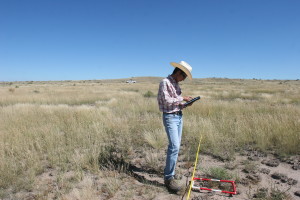Grazing cattle and sustaining bobwhite quail can be part of the same equation, says Kelly Reyna, our partner with UNT Quail. Reyna and our Bear Creek Unit were recently featured in this article, “Saving a Texas rite of passage, one ranch at a time,” on the North Texas Quail Corridor, an initiative to conserve this treasured but increasingly scarce game bird.
Dixon-funded research on small rodents featured in Aggie news and Big Bend Sentinel
A Dixon-funded research project by Sul Ross State University graduate student Bobby Allcorn was featured recently the Big Bend Sentinel and the Aggie News Network from Texas A&M University. Allcorn has been monitoring small rodent populations at Mimms Unit after the Rock House Fire in 2011.
North Texas Land Scholars program slated for July 2014
One of the Dixon Water Foundation’s grant recipients is the North Texas Land Scholars program. This camp, tentatively scheduled for July 13-17, 2014, aims to connect youth to nature by improving their scientific literacy while teaching the value of land stewardship.
Soil still teems with life after fire, SRSU student finds
MARFA – Two years ago, the Rock House Fire and a record drought scorched most of the Dixon Water Foundation’s Mimms Ranch outside Marfa. The effects aboveground are still obvious, where grasslands are punctuated by patches of barren earth. But how did the fire and drought affect microbes toiling in the soil to create the nutrients grasslands require? This subterranean recovery was studied recently by Masahiro Ohnishi, a Natural Resource Management graduate student at Sul Ross State University in Alpine.
“We wanted to see what kinds of bacteria and archaea are in the soil after the fire and after the drought, and how they recovered from these huge disturbances,” says Ohnishi, whose research was funded by the Dixon Water Foundation, a non-profit that promotes healthy watersheds through sustainable land management.
Bacteria and archaea are single-celled microscopic organisms that are found practically everywhere—from deep-sea vents and arctic glaciers, to cattle intestines and human belly buttons. Many microbes belong to nature’s recycling crew; they break down dead plants and convert them into nutrients required by living plants. Microbes also help create a complex soil texture, which in turn allows seeds to take hold and more rainwater to soak into the ground. All of these functions make soil microbes essential members of a desert grassland ecosystem.
To determine which microbes populate Mimms Ranch, Ohnishi analyzed the microbial DNA in soil samples collected from several unburned, burned and intensely overgrazed sites. Then he used statistical analyses to compare these microbial communities before and after the summer rainy season in 2012. He also looked for correlations with the amount of plant cover, soil nutrients, and other soil characteristics at each study site.
In burned areas, Ohnishi found nearly half as much microbial DNA as in unburned areas, indicating soil microbes had been hit hard by the fire and drought. But microbial activity recovered after the summer rainy season at both burned and unburned sites. Ohnishi observed a corresponding increase in the amount of certain soil nutrients needed by grasses and other plants, which also bounced back after the summer rains.
Ohnishi was particularly amazed by the diversity of soil microbes he encountered. For example, one five-gram soil sample—the weight of a nickel—was home to around 400 types of bacteria.
“There’s so much diversity, and these microbes perform so many functions,” he said. “We have no clue what they all do yet.”
Understanding what each soil microbe does will be up to future researchers. For now, Ohnishi’s research demonstrates that these microbes are part of the recovery process after a devastating fire and drought. And he envisions his research contributing to a micro-ecosystem approach to land management, in which supporting microbial activity would be a way to improve rangeland health.
Bonnie Warnock, associate professor of range science at Sul Ross State University, directed Ohnishi’s research.
“Both the physical and biological health of the soil is critical to healthy ecosystems,” she said. “We tend to take the soil for granted and forget that it is, in a very real way, the base for all life.”
Dixon funds Sul Ross researchers developing cattle for desert
This article in the Big Bend Sentinel describes Sul Ross researchers breeding cattle suited for grazing desert grasslands. Their research was funded by a grant from the Dixon Water Foundation.
Dixon pledge to pronghorn recovery benefit featured in Alpine Avalanche
From the Alpine Avalanche:
The Dixon Water Foundation of Marfa and the Horizon Foundation of Dallas have pledged up to $50,000 for this weekend’s Pronghorn Restoration Benefit Dinner and Dance.
The Pronghorn Restoration Benefit is scheduled for 6 p.m. Saturday, Jan. 29, at the Granada Theater in downtown Alpine. Local landowners will serving locally grown ribeye steaks with all the fixings; a cash bar will also be available.
The program also includes a silent auction, a brief presentation on pronghorn in West Texas and an outline of the restoration plan. The evening will culminate with a dance featuring Craig Carter and the Spur of the Moment Band.
The pledge comes in the form of a challenge grant where the foundations have committed a dollar to dollar match for up to $50,000 raised during the benefit.
The benefit is spearheaded by the Trans-Pecos Pronghorn Working Group made up of local ranchers, conservationists and researchers with the Borderlands Research Institute at Sul Ross State University who are concerned with the recent demise of pronghorn in the region. Figures put the population at an all-time low of 4,800. The Pronghorn Working Group has helped implement a series of investigations into the pronghorn decline.


